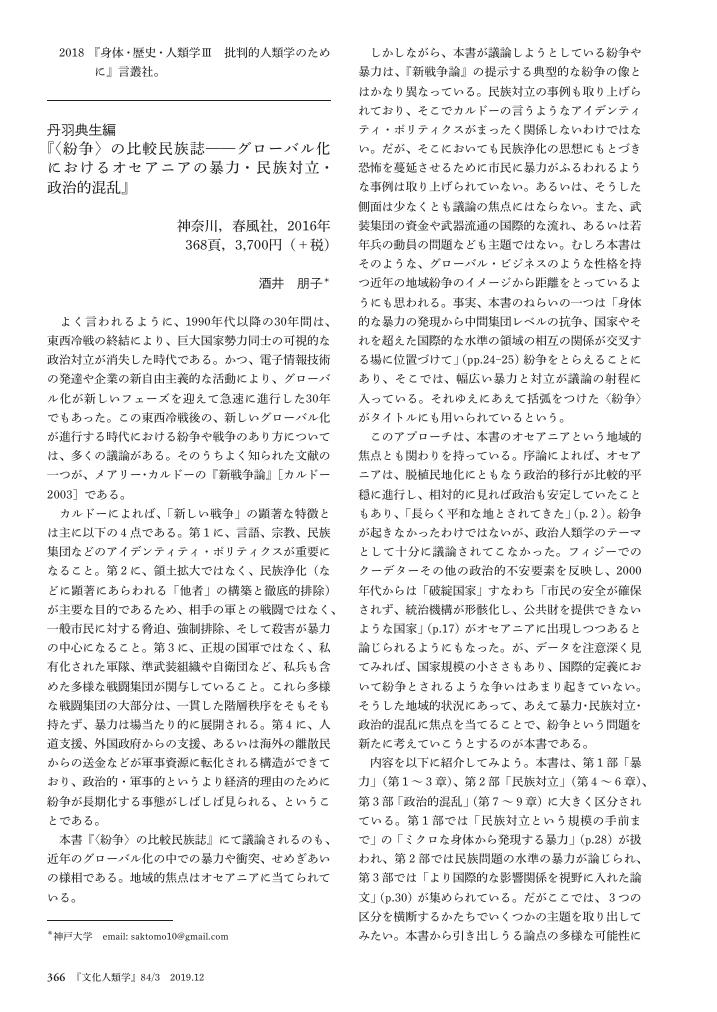- 著者
- 酒井 朋子
- 出版者
- 社会学研究会
- 雑誌
- ソシオロジ (ISSN:05841380)
- 巻号頁・発行日
- vol.50, no.1, pp.51-67,167, 2005
Past studies of collective memory have focussed on how negative emotions, like anger or grief, are concealed by or tamed within the history represented. On the other hand, it has been argued that resentment is a basis of social action and its form, as we can see that in the process of class formation. Then, do not people with the self-consciousness of being oppressed in a social structure, project their resentment in their own histories? This paper aims to examine this question by analysing an account of the First World War by Ulster Loyalists, who claimed their hardship as members of the Protestant Working Class in the Northern Ireland society in the 1970s.<br> In a pamphlet published in the 1970s Loyalists described their social experience as a story in which their hard work was neglected by Britain and by Protestant upper-class politicians. At the same time, they also described the experience of serving in the Great War as miserable work with no reward, and juxtaposed it with their other experiences of oppression. Further, they related a story of one battle in which Britain betrayed Ulster's devotion, and forced a huge number of Ulster soldiers to die meaninglessly. The plots of these stories are the same: first devotion, then betrayal, and finally suffering.<br> What we can see in this process of giving a plot to a past event, is a mechanism in which people create or discover "the same" experience and emotion in the past in their social imaginations. In the case this paper examines social and economical hardship were described in such a way that reinforced their nationalism and hostility towards the other, Catholic group. But when such an imagination crosses social categories, for instance, of religion, nation and race, it is also supposed to have the possibility of revealing the contingency of such categories.
- 著者
- 酒井 朋子
- 出版者
- 「宗教と社会」学会
- 雑誌
- 宗教と社会 (ISSN:13424726)
- 巻号頁・発行日
- no.11, pp.43-62, 2005-06-11
本稿は、深刻な民族的・宗派的対立が継続してきた北アイルランドにおいて、第一次大戦戦死者がいかにユニオニズムの英雄として語られてきたのかを論じるものである。とくに大戦と名誉革命期の戦いとを重ねあわせる語りや記念行事に着目し、その形成過程、ならびにその後の大戦解釈への影響力を検討する。多くのユニオニストが戦死した第一次大戦下のソンム会戦は、その開戦の日付がユニオニズム・シンボルであった名誉革命期ボイン戦の記念日と一致していたため、ボイン戦に結び付けられて語られ記念されるようになっていった。戦後50年を経ると、穏健派のユニオニスト政権の登場もあって、二つの出来事の重ねあわせを否定し戦場の悲惨さを強調して戦争を脱神秘化しようとする語りが公の場に現れるようになる。しかし紛争激化以降、強硬派の武装組織は、名誉革命を想起しつつ惨死を遂げていった悲劇的英雄として戦死者を描出し、自集団のシンボルとして大戦を掲げていくのである。
1 0 0 0 OA 歩行開始における脳卒中片麻痺患者の体幹運動特性
- 著者
- 大沼 亮 星 文彦 松田 雅弘 酒井 朋子 神野 哲也
- 出版者
- The Society of Physical Therapy Science
- 雑誌
- 理学療法科学 (ISSN:13411667)
- 巻号頁・発行日
- vol.37, no.4, pp.427-432, 2022 (Released:2022-08-20)
- 参考文献数
- 18
〔目的〕脳卒中片麻痺患者の歩行開始時の体幹運動特性について検証した.〔対象と方法〕対象は健常高齢者10名と脳卒中片麻痺患者30名とした.重心動揺計,表面筋電計,加速度計を用い,歩行開始時の体幹運動を計測した.筋電図は左右の中殿筋と脊柱起立筋の4筋を導出筋とし,加速度は頸部(C7),腰部(L3),骨盤(S1)に貼付し,測定した.〔結果〕脳卒中片麻痺患者の筋活動潜時は,麻痺側先行ステップ時の麻痺側中殿筋,非麻痺側先行ステップ時の麻痺側脊柱起立筋が非麻痺側より遅延していた.加速度はC7からL3を引いた差の値(dCL)の比較において,健常高齢者と脳卒中片麻痺患者の麻痺側先行ステップで立脚側方向へdCLが変化していたのに対して,非麻痺側先行ステップで遊脚側方向へ変化がみられた.〔結語〕脳卒中片麻痺患者の歩行開始において,先行肢別に体幹が傾斜する代償制御と動き出しが遅延する遅延制御の異なるパターンの運動戦略を呈した.
- 著者
- 酒井 朋子
- 出版者
- 日本文化人類学会
- 雑誌
- 文化人類学 (ISSN:13490648)
- 巻号頁・発行日
- vol.84, no.3, pp.366-368, 2019 (Released:2020-02-12)
- 参考文献数
- 2
1 0 0 0 映像作品「NOW」
- 著者
- 丸井 隆志 酒井 朋子
- 出版者
- 一般社団法人映像情報メディア学会
- 雑誌
- 映像情報メディア学会技術報告 (ISSN:13426893)
- 巻号頁・発行日
- vol.24, no.23, pp.43-44, 2000-03-14
5人の若者がありふれた毎日の中で繰り広げる青春映画。ある日、久し振りに仲間の元へ帰ってきた脇谷。彼は1ヶ月一人旅をしていた。久し振りに顔を合わせた5人、南野、井出、哲治、大輔そして脇谷がまずすることといったら麻雀、そして大学の休み時間には野球をするという日々。そんな彼らが引き起こす恋や悩み、そして友情を描く。

